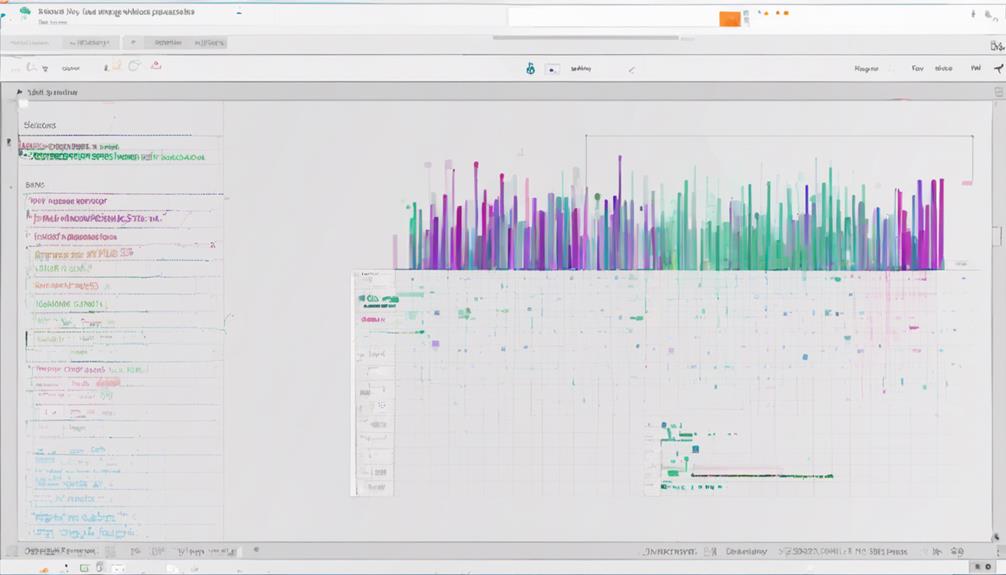In a world where data reigns supreme, the difference between success and stagnation lies in its accuracy and utility. Imagine the vast landscape of industries being reshaped by the meticulous process of data scrubbing. From uncovering hidden patterns in healthcare to fortifying financial security measures, the impact is profound. As you explore each sector’s unique transformation, you’ll discover how data scrubbing is revolutionizing different industries, not merely as a trend but as a strategic imperative driving unparalleled advancements across diverse fields.
Healthcare
In the realm of healthcare, data scrubbing has emerged as a transformative tool reshaping how patient information is managed and utilized. By meticulously cleaning and enhancing datasets, data scrubbing contributes significantly to improving patient outcomes and ensuring data security within healthcare systems.
Patient outcomes are directly influenced by the accuracy and completeness of medical records, which data scrubbing helps to maintain. By identifying and rectifying errors, duplicates, and inconsistencies within patient data, healthcare providers can make more informed decisions, leading to better treatment plans and ultimately improved outcomes for patients.
Moreover, data security is paramount in healthcare due to the sensitive nature of patient information. Data scrubbing plays a vital role in safeguarding this data by removing irrelevant or outdated information, ensuring compliance with data protection regulations, and minimizing the risk of unauthorized access or breaches. This proactive approach to data security not only protects patient confidentiality but also fosters trust between healthcare providers and their patients.
Finance
Transforming the financial sector, data scrubbing revolutionizes how banking institutions and investment firms manage their vast datasets. Through advanced algorithms and machine learning techniques, data scrubbing plays a pivotal role in enhancing fraud detection within the finance industry. By identifying anomalies, inconsistencies, and suspicious patterns in financial data, institutions can proactively prevent fraudulent activities before they escalate. This not only safeguards the financial institutions but also protects the interests of customers and stakeholders.
Moreover, data scrubbing significantly contributes to enhancing risk management practices in finance. By ensuring data accuracy, completeness, and consistency, organizations can make informed decisions based on reliable information. This leads to more effective risk assessment, mitigation strategies, and compliance with regulatory requirements. By scrubbing and refining data continuously, financial institutions can stay ahead of potential risks and uncertainties, thus maintaining a competitive edge in the dynamic market landscape. Ultimately, data scrubbing is reshaping the finance sector by fostering a secure, efficient, and transparent environment for all stakeholders involved.
Retail
Within the realm of Retail, data scrubbing emerges as a game-changer in how businesses streamline operations and optimize customer experiences. By leveraging data scrubbing techniques, retailers can enhance their customer segmentation strategies, tailoring marketing campaigns and product offerings to specific demographic groups. This targeted approach not only increases customer engagement but also boosts overall sales performance.
Moreover, data scrubbing plays a crucial role in efficient inventory management. By ensuring that product data is accurate and up-to-date, retailers can prevent stockouts, reduce excess inventory, and ultimately improve their bottom line. Through regular data cleansing processes, businesses can maintain a real-time view of their inventory levels, enabling better decision-making regarding restocking, promotions, and product placements.
Telecom
Amidst the rapidly evolving landscape of the Telecom industry, data scrubbing emerges as a pivotal tool reshaping operational efficiency and customer satisfaction. In this dynamic sector, network optimization plays a crucial role in ensuring seamless connectivity and service delivery. By leveraging data scrubbing techniques, telecom companies can analyze network performance, identify bottlenecks, and enhance overall efficiency. This leads to improved service quality, reduced downtime, and increased customer retention.
Moreover, customer segmentation is another area where data scrubbing proves invaluable. By cleaning and organizing customer data effectively, telecom companies can gain valuable insights into customer behavior, preferences, and needs. This allows for targeted marketing campaigns, personalized services, and tailored offerings that resonate with different customer segments. Ultimately, this leads to higher customer satisfaction, increased loyalty, and a competitive edge in the market.
Manufacturing
With advancements in technology revolutionizing the manufacturing industry, data scrubbing has emerged as a critical tool for enhancing operational efficiency and productivity. By cleaning and organizing manufacturing data, companies can streamline processes and make informed decisions.
- Supply Chain Visibility: Data scrubbing enables real-time monitoring of inventory levels, supplier performance, and demand forecasts, improving supply chain visibility.
- Quality Control: Through data scrubbing, manufacturers can identify patterns of defects or errors in production, leading to enhanced quality control measures.
- Production Planning: Clean data allows for better forecasting and planning, optimizing production schedules and resource allocation.
- Cost Reduction: By eliminating redundant or inaccurate data, companies can reduce waste, lower production costs, and increase profitability.
Data scrubbing plays a crucial role in not only maintaining a smooth supply chain but also in driving production optimization efforts within the manufacturing sector. Companies adopting data scrubbing practices are better positioned to adapt to changing market demands and improve overall operational efficiency.
Logistics
In the realm of logistics, the efficient management of transportation, warehousing, and distribution is essential for ensuring the seamless flow of goods from production to consumption. Data scrubbing plays a vital role in optimizing logistics operations by enhancing supply chain visibility and streamlining inventory management processes. Through the use of clean and accurate data, companies can make informed decisions regarding inventory levels, demand forecasting, and transportation routes.
Supply chain efficiency is greatly improved through data scrubbing techniques that help identify bottlenecks, reduce lead times, and enhance overall operational performance. By scrubbing and analyzing data related to supplier performance, inventory levels, and demand patterns, organizations can proactively address potential issues and optimize their supply chain networks.
Furthermore, inventory management benefits significantly from data scrubbing by ensuring that inventory records are up to date, accurate, and reflective of real-time demand fluctuations. This leads to improved inventory turnover rates, reduced carrying costs, and enhanced customer satisfaction levels. Overall, leveraging data scrubbing in logistics enhances operational agility and competitiveness in today’s fast-paced business environment.
Energy
As you explore the impact of data scrubbing on the energy sector, you will find a notable emphasis on efficiency. By harnessing the power of data scrubbing techniques, energy companies can optimize their operations, leading to reduced resource wastage and improved overall efficiency. This enhanced efficiency not only benefits the environment but also translates into significant cost reductions for businesses operating in the energy industry.
Efficiency in Energy
Amidst the rapidly evolving landscape of energy technologies, data scrubbing is playing a pivotal role in enhancing efficiency within the energy sector. By leveraging data cleansing techniques, the energy industry can optimize operations, improve grid management, and drive the adoption of renewable energy sources like solar and wind power. Here are four ways data scrubbing is revolutionizing efficiency in energy:
- Enhanced Predictive Maintenance: Data scrubbing helps analyze vast amounts of data from smart grids to predict maintenance needs accurately, reducing downtime and optimizing asset performance.
- Improved Demand Forecasting: Through cleaning and analyzing consumption data, energy providers can forecast demand patterns more precisely, leading to better resource allocation and reduced wastage.
- Optimized Energy Distribution: Data scrubbing enables utilities to better manage energy distribution networks, ensuring efficient power flow and minimizing losses.
- Enhanced Energy Efficiency: By cleaning and analyzing data from smart meters and IoT devices, energy consumption patterns can be understood better, leading to tailored strategies for boosting energy efficiency.
Data scrubbing is undeniably reshaping the energy sector, driving efficiency, sustainability, and innovation.
Cost Reduction Benefits
Consider the significant cost reduction benefits that data scrubbing offers to the energy sector. By implementing data scrubbing techniques, energy companies can enhance their fraud detection capabilities. Through the identification of irregularities or anomalies in billing or usage patterns, data scrubbing plays a crucial role in preventing revenue loss due to fraudulent activities. Moreover, data scrubbing enables precise customer segmentation within the energy sector. By accurately categorizing customers based on their consumption patterns, preferences, and behavior, energy companies can tailor their services more effectively, leading to improved customer satisfaction and retention. This targeted approach allows energy companies to optimize their resource allocation, streamline operations, and reduce unnecessary expenditures. Overall, the cost reduction benefits of data scrubbing in the energy sector are substantial, offering companies the opportunity to operate more efficiently and competitively in a rapidly evolving market landscape.
Education
Revolution in data scrubbing is reshaping the landscape of education, offering institutions tools to enhance efficiency and accuracy in handling vast amounts of information. Data scrubbing is playing a vital role in improving student performance and curriculum development. Here are four ways data scrubbing is transforming education:
- Personalized Learning: Data scrubbing allows educators to analyze individual student data, enabling personalized learning experiences tailored to each student’s needs.
- Predictive Analytics: By cleaning and analyzing data effectively, institutions can utilize predictive analytics to forecast student performance trends and intervene proactively to support struggling students.
- Curriculum Optimization: Data scrubbing helps in identifying gaps in curriculum delivery, enabling educators to enhance teaching strategies and improve overall curriculum development.
- Resource Allocation: Efficient data scrubbing ensures accurate resource allocation, optimizing budgeting decisions and ensuring resources are directed where they are most needed.
Real Estate
Real estate professionals like you are benefiting from data scrubbing technologies that are transforming the industry. By utilizing advanced data scrubbing techniques, property valuation processes are becoming more accurate and efficient. Additionally, market analysis is being enhanced, and listing management is becoming more streamlined, allowing for better decision-making and improved customer experiences.
Improved Property Valuation
Through the process of data scrubbing, the real estate industry has experienced a significant transformation in how property valuation is conducted. Data quality plays a crucial role in enhancing appraisal accuracy, while the integration of market trends and predictive analytics has further revolutionized property valuation methods.
- Enhanced Data Accuracy: Data scrubbing ensures that property information is up-to-date and accurate, leading to more precise valuations.
- Improved Appraisal Accuracy: By cleaning and organizing data effectively, the appraisal process becomes more reliable and reflective of the property’s true value.
- Utilization of Market Trends: Data scrubbing enables real estate professionals to analyze and incorporate current market trends into property valuations for a more comprehensive assessment.
- Predictive Analytics Integration: Through data scrubbing techniques, predictive analytics can be applied to forecast future property values accurately, aiding in strategic decision-making processes.
Enhanced Market Analysis
In the realm of real estate, an intricate web of data intertwines to shape market dynamics and influence decision-making processes. Enhanced market analysis through data scrubbing offers real estate professionals a competitive edge by enabling precise customer segmentation and predictive modeling. By leveraging clean and accurate data, professionals can identify trends and patterns in the market, allowing for strategic decision-making and improved forecasting.
Data scrubbing facilitates comprehensive competitive analysis, providing insights into the strengths and weaknesses of competitors in the real estate market. This information is invaluable for developing marketing strategies and positioning properties effectively to attract buyers. Furthermore, predictive modeling based on scrubbed data helps in anticipating market trends and adjusting strategies accordingly to stay ahead of the curve.
Streamlined Listing Management
Efficiently managing property listings in the real estate sector is a critical aspect of operations that can significantly impact success. In this industry, the use of data scrubbing techniques can revolutionize the way listings are handled, leading to improved efficiency and better outcomes. By focusing on data accuracy and inventory optimization, real estate professionals can streamline their listing management processes effectively. Here are four ways in which data scrubbing is transforming listing management in real estate:
- Automated Updates: Implementing automated systems for updating property listings ensures that information remains current and relevant at all times.
- Improved Visibility: By ensuring data accuracy, listings can be more easily searchable and visible to potential buyers or tenants.
- Enhanced Inventory Optimization: Data scrubbing enables real estate agents to optimize their inventory by accurately categorizing and presenting properties.
- Efficient Decision-Making: With clean and reliable data, professionals can make informed decisions swiftly, leading to better outcomes in the real estate market.
Technology
Revolutionizing numerous industries, data scrubbing has emerged as a transformative force driven by advancements in technology. With data security and privacy becoming paramount concerns, technological innovations have played a crucial role in enhancing the efficacy of data scrubbing processes. Through sophisticated algorithms and machine learning capabilities, data scrubbing tools can now detect and eliminate sensitive information, ensuring compliance with stringent privacy regulations.
The integration of artificial intelligence has revolutionized the data scrubbing landscape, enabling automated identification and removal of duplicate or inaccurate data points. This not only enhances the accuracy of databases but also safeguards against potential security breaches. Additionally, advancements in cloud computing have facilitated the seamless processing of large datasets, allowing organizations to efficiently cleanse their data repositories while minimizing downtime.
Government
The government sector is undergoing a significant transformation driven by the adoption of data scrubbing technologies. This evolution is reshaping how governmental entities handle information, leading to improved data transparency and enhanced policy enforcement.
- Increased Data Transparency: Data scrubbing tools help government agencies clean and organize large datasets, making information more accessible to the public and increasing accountability.
- Enhanced Policy Enforcement: By utilizing data scrubbing techniques, governments can more effectively identify inconsistencies or errors in datasets, enabling better enforcement of policies and regulations.
- Streamlined Decision-Making Processes: Data scrubbing technologies aid in removing duplicate or inaccurate data, allowing policymakers to base their decisions on reliable and up-to-date information.
- Cost Savings: Implementing data scrubbing solutions can lead to cost savings for governments by reducing the time and resources needed to manually clean and validate data sets, ultimately improving operational efficiency.
Non-profit
Non-profits stand to benefit significantly from data scrubbing techniques by improving their fundraising efforts and enhancing donor engagement. With clean and accurate data, organizations can target potential donors more effectively, resulting in increased donations and support for their causes. Utilizing data scrubbing tools can streamline operations, identify trends in donor behavior, and ultimately lead to a more impactful and efficient fundraising strategy.
Impact on Fundraising
As data scrubbing techniques become more widely adopted, the influence on fundraising within the non-profit sector is becoming increasingly pronounced. By leveraging data cleaning processes, non-profits can enhance their fundraising efforts through improved donor targeting and campaign optimization.
- Enhanced Donor Targeting: Data scrubbing allows non-profits to segment their donor databases effectively, enabling personalized communication and targeted fundraising appeals.
- Improved Campaign Optimization: Clean data leads to more accurate donor insights, helping non-profits tailor their fundraising campaigns for better engagement and higher success rates.
- Increased Fundraising Efficiency: Data scrubbing streamlines fundraising processes, reducing time and resources spent on ineffective outreach efforts.
- Enhanced Donor Relationships: By utilizing clean data, non-profits can build stronger relationships with donors based on accurate information, leading to increased donor loyalty and support.
Incorporating data scrubbing techniques into fundraising strategies empowers non-profits to maximize their fundraising potential and drive greater impact in their charitable endeavors.
Enhancing Donor Engagement
Transforming donor engagement in the non-profit sector, data scrubbing techniques play a pivotal role in optimizing interactions and fostering lasting connections with supporters. By utilizing donor segmentation through data scrubbing, non-profits can identify different donor groups based on various criteria such as giving history, interests, and engagement level. This segmentation allows organizations to tailor personalized communication strategies that resonate with each donor segment, ultimately enhancing donor engagement.
Moreover, data scrubbing assists non-profits in running more targeted fundraising campaigns. By ensuring clean and accurate donor data, organizations can effectively reach out to potential donors with relevant messaging, leading to increased donations and overall campaign success. Additionally, the precise data obtained through scrubbing enables non-profits to implement strategies for donor retention, understanding donor preferences, and behaviors to create meaningful and long-lasting relationships.
Frequently Asked Questions
How Does Data Scrubbing Impact Customer Satisfaction in the Retail Sector?
When data scrubbing is utilized in retail sales, it refines customer feedback, leading to improved satisfaction. By enhancing data accuracy and personalizing customer experiences, businesses can tailor their offerings effectively, ultimately boosting customer loyalty and retention.
What Are the Potential Cybersecurity Risks Associated With Data Scrubbing in Technology?
When data scrubbing is not done meticulously, data privacy becomes vulnerable to cyber threats. Stay vigilant to prevent breaches. Regularly update security measures and ensure only necessary data is retained. Protect your organization from potential cybersecurity risks.
Can Data Scrubbing Improve Supply Chain Efficiency in Logistics?
Improve supply chain efficiency by optimizing inventory and routes through data scrubbing. Enhance logistics operations by ensuring accurate data for streamlined processes. Utilize this method to refine decision-making and boost overall performance in your supply chain.
How Does Data Scrubbing Influence Student Performance in Education?
Data scrubbing enhances academic success by analyzing learning outcomes data. It identifies trends, highlights areas for improvement, and ensures accurate assessments. By refining student data, educators can tailor interventions, boost performance, and optimize educational strategies effectively.
What Are the Ethical Considerations of Data Scrubbing in Government Agencies?
When considering data scrubbing in government agencies, privacy concerns and data accuracy are paramount. Ensuring ethical practices is crucial to maintain public trust. Transparency and accountability are essential in navigating the complexities of data manipulation.



